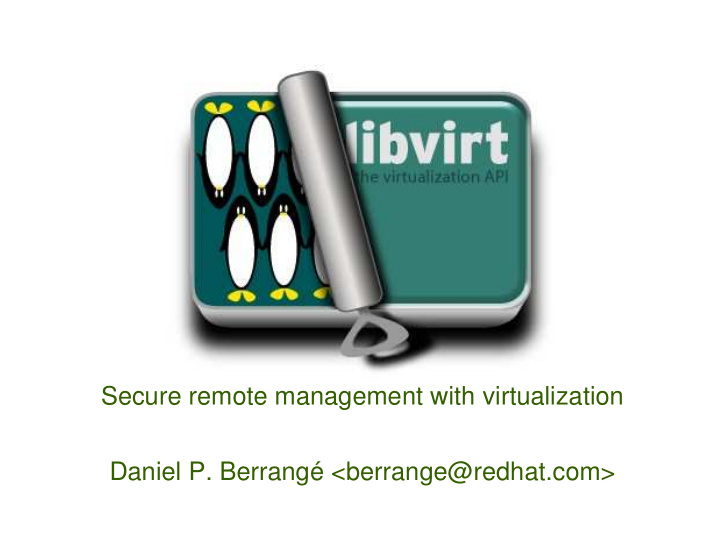



Secure remote management with virtualization Daniel P. Berrangé <berrange@redhat.com>
libvirt: Background ● API for management of hypervisors ● Community (Red Hat, Fujitsu, Bull) ● Isolates apps from HV specific APIs ● Driver support for Xen, QEMU, KVM ● C, Python, Perl, shell APIs ( virsh )
libvirt: Local Architecture
libvirt: Remote Management ● Local management unchanged ● Driver talks to remote libvirtd server ● XDR messaging protocol (rfc 1832) ● Layered over TLS 1.1 or tunnel SSH ● x509 certificate authentication ● Role based MAC with SELinux
libvirt: Remote Architecture
libvirt: Host Capabilities ● Supported architectures: x86, ppc, sparc ● Supported virt types: Xen, KVM, QEMU, KQEMU ● Supported OS types: Xen PV, HVM ● CPU capabilities: SVM, VMX, PAE
libvirt: Network Management ● Shared physical device / virtual network ● APIs to define virtual networks ● dnsmasq provides DHCP + DNS ● Isolated or NAT forwarding (iptables) ● Solve NetworkManager/Laptop case
libvirt: Storage Management ● Storage pool of file, partition, or lvm ● Enumeration volumes in pool ● Allocate virtual disks from pool ● Verify availability for migration ● POSIX (file), GpartD (partition), ??? (lvm)
libvirt: Graphics Console ● Xen, QEMU, KVM provide VNC server ● VNC unencrypted traffic, 'trivial' auth ● Goal for parity auth scheme with libvirt ● VeNCrypt extension adds TLS + x509 ● Port PV daemon to use QEMU VNC code ● GTK-VNC client supports VeNCrypt
libvirt: Text Console ● Xen, QEMU, KVM provide Pseudo-TTY ● Restricted to root on local machine ● QEMU provides UNIX/TCP socket access ● Goal for parity auth scheme with libvirt ● Existing tool ? Tunnel VNC / libvirt ?
http://libvirt.org/
Recommend
More recommend